The piece of the month of June 2017
THE GOLDEN BOOK OF NAVARRA TO H.H. POPE PIUS XII
Francisco Javier Zubiaur Carreño
Chair of Navarrese Heritage and Art
1950 was the Holy Year "of the great return and of the great forgiveness", declared by Pope Pius XII on a horizon full of tensions and with the wounds of the Second World War still open. A message of peace underlies this Jubilee of all people, including those farthest from the Christian faith, despite the difficulty for Eastern European Catholics to come to Rome. The moment when His Holiness Pius XII proclaimed the dogma of the Assumption of Mary to the whole world, represented at St. Peter's place by 500,000 faithful and 622 bishops, was defined as "the best preaching of the century".
Navarra did not want to remain indifferent to this great religious event that was presented as an occasion for reconciliation, conversion and sacramental penance. For this reason, the Diocese of Pamplona, in accordance with the Christian past of Navarre, wanted to offer the Holy Father a testimony of its living faith materialized in a personalized album that collected the report of its religious trajectory through the centuries. Antonio Ona de Echave, parish priest of San Lorenzo (Pamplona), had begun the work leading to what would be more appropriately called the Golden Book of Navarre, whose initiative was gladly joined by the Provincial Council, which, once it was completed, would be delivered to His Holiness by a commission of provincial deputies who traveled to Rome, presided over by the Bishop of the Diocese, Mons. Enrique Delgado Gómez, and formed by Jesús Larráinzar Yoldi, Carmelo del Villar Callén and José Ángel Zubiaur Alegre, my father, whom the Foral Corporation, by agreement of June 30, 1950, had designated to organize and direct, counting on the necessary collaborations and help, the work of preparation of the aforementioned work. In it, reads the agreement of the Deputation, "the religious activities of this Old Kingdom and the contributions of blood and other goods with which both its children and the Entities of the same have always contributed to the cause of the Catholicity of the Church".
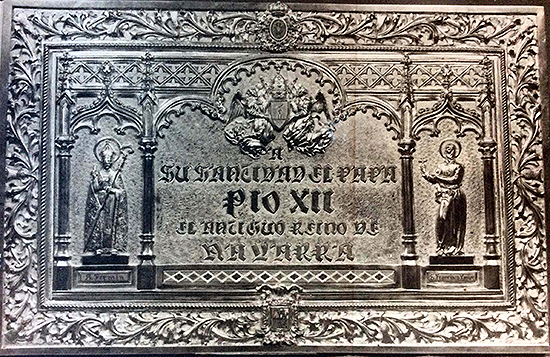
Cover of the original in silver (Talleres de Arte)
(Photograph by Francisco Zubieta)
The Book was conceived as a unique copy of agreement for its special significance, an imitation of a manuscript ecclesiastical codex with gothic handwriting and miniated in the traditional manner, containing sixty parchment leaves bound in Roman style with gilded silver covers and in landscape format. On the upper part of the cover was the coat of arms of Navarre with enamels, in the center that of His Holiness, below that of Spain, and on the sides the images of San Fermín and San Francisco Javier, patrons of our Community, protected under a triple arcade of Gothic ogee arches on the sides flanking a central one of the three-lobed carpanel subject that shelters the dedication. The whole composition is bordered by a fine groove with a border of leaves with a soft curvilinear rhythm. The legend read: "To His Holiness Pope Pius XII, the ancient Kingdom of Navarre". On the back were the coat of arms of Navarre, that of the diocesan bishop on the right and that of Pamplona on the left, within Gothic style quadrilobed rosettes, the one of Navarre having a larger diameter, centered in a panel furrowed in relief by converging lines that release rhombuses in whose interior quadripetal rosettes of Islamic flavor had been inserted, the whole panel crossed externally by the chains of the Kingdom, a cord and a border with a succession of vegetal stems forming soft arabesques of Gothic breath. Above the Navarrese coat of arms the words HOLY YEAR and below the year of the jubilee: 1950.
The inside pages reflected the history of Navarre in its religious life, both in the past and in the present, as well as the contributions of Navarre's institutions to the religious and social development . The table of contents contained the following chapters paginated with Roman numerals:
|
The Diocese of Pamplona |
I |
|
The Cathedral |
IX |
|
Catalog of Bishops of this Diocese |
XI |
|
Current statistics of temples, hermitages, confraternities, pious associations, etc. |
XIV |
|
Vocational sign of Navarra |
XXI |
|
Mission Secretariat |
XXIII |
|
Catechetical Secretariat |
XXV |
|
Secretariat of Spiritual Exercises |
XXXI |
|
Catholic Action |
XLII |
|
The Marian Congregation |
XLVIII |
|
The Romerías |
LIII |
|
The Spanish Crusade |
LXII |
|
The teaching in Navarra |
LXIX |
|
Social Action |
LXXVII |
|
Prince of Viana Institution |
LXXXI |
|
San Miguel Sanctuary |
CXI |
|
The Charity |
CXIII |
The Issue did not present the usual credits in printed books but was configured as report of a community, the people of Navarre, although numerous people contributed to its elaboration, some in the literary field or by providing information, and others in the artistic field, whose names we know because they are mentioned in the official documentation.
There were disinterested collaborations such as those of the priests Teodosio Aoiz, Agustín Arbeloa Egüés, Alejandro Maisterrena Etuláin, Casimiro Saralegui Lorea, José Goñi Gaztambide, Jesús García Mendiri, the community of Salesian and Jesuit priests, as well as the aforementioned Antonio Ona de Echave. Among the non-ecclesiastical collaborators, Dolores Baleztena Ascárate, Javier Donézar Sarasíbar, José Esteban Uranga Galdiano, Fermín Mugueta Sarasa, Francisco López-Sanz Latasa, Manuel Laguna Buitrago and José Ángel Zubiaur Alegre wrote in it. data The two Navarre Savings Banks (Municipal and Provincial) and the business Pedro Mayo provided financial support.
The artistic part is undoubtedly the most interesting for us, since the Gold Book involved goldsmiths, bookbinders, draftsmen and bookbinders. Leocadio Muro Urriza, a famous illustrator for his seriousness and neatness in the work, was in charge of these professionals and the artistic direction of all of them and of the distribution of the pages of the Book, with the consequent responsibility and work of ornamentation, and he also worked as a draftsman, all of them hired for this purpose. The total expenses, what today we would call production of the book, amounted to 61,710 pesetas.
The draftsmen were the priest Nicasio Albéniz Armendáriz, Leocadio Muro Urriza, Antonio de Assas y Zabala, José Félix Erice Echaide, the brothers Juan María and Juan Luis Cía Gaetano, Pedro Lozano de Sotés, Alfredo Surio de la Cuesta and Ignacio Gatell. José Ayestarán provided the parchments through the business tannery of his name in Calderería Street in Pamplona, the Talleres de Arte, of Madrid, designed and made the covers, and José Azurza was in charge of ordering the parchment sheets of the book in branch for its binding with the silver covers and clasps in the aforementioned Madrid workshops, which were personally taken to the capital by the private secretary of the deputy Zubiaur, Pedro Erro Galar.
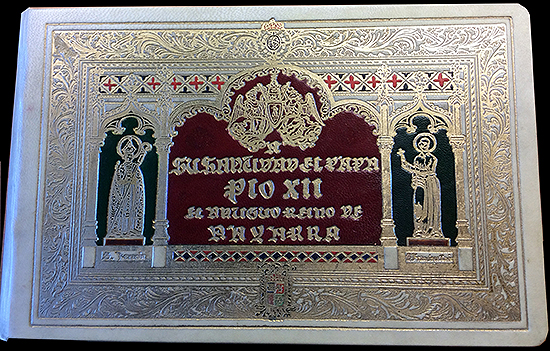
Cover of the parchment copy (Encuadernaciones Azurza)
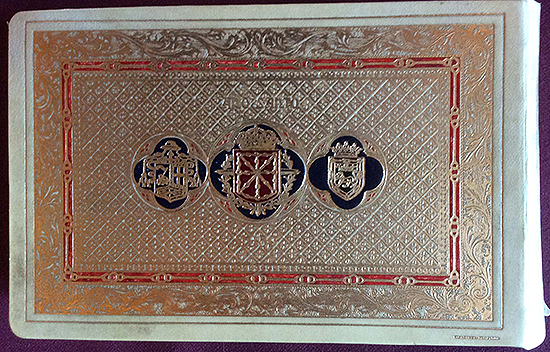
Back cover of the parchment copy (Encuadernaciones Azurza)
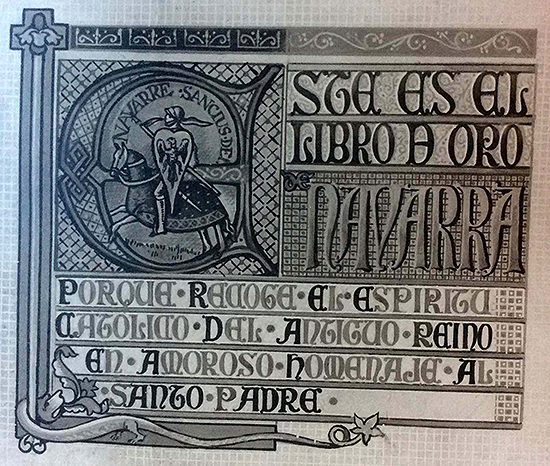
Cover (Photograph by Francisco Zubieta)
At least three copies of such black and white photographic copies of the original album are preserved in the libraries of Navarre: two in the Royal and General file and one in the Monastery of Leire. The photographic reproduction, made by Francisco Zubieta Vidaurre, on which I will focus my analysis because it is the one of free access that allows us to imagine the richness of the original manuscript in the Vatican, has as degree scroll the one on the cover, A SU SANTIDAD EL PAPA PIO XII, THE OLD KINGDOM OF NAVARRA, and, on the title page, at the beginning of the book, also in capital letters in Gothic style, THIS IS THE BOOK OF [in nexus] GOLD OF NAVARRA [this word in larger characters], FOR IT COLLECTS THE CATHOLIC SPIRIT OF THE OLD KINGDOM IN LOVING TRIBUTE TO THE HOLY FATHER. The design of this page is very beautiful, surely miniature by Muro Urriza for the elegance and stylization of the characters and the figures represented. In her a knight of luengo shield with the royal eagle emblem of Sancho VII the Strong king of Navarre, with lance in ristre and plume of the helmet to the wind is represented on cavalcade elegantly dressed with gualdrapa under the legend NAVARRE . SANCIUS . DEI, all this inside the capitular letter E, which begins the text neatly defined in several lines, the words of the four lower bands separated by dots, and largely bordered with vegetal borders and a square on the side of the spine in which a graceful dragon with a stylized tail and whose mouth exhales a flame whimsically turned into leaves is curled.
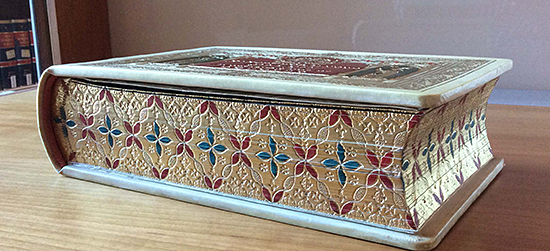
Ornamentation of the copy cut (Encuadernaciones Azurza)
The dimensions in centimeters of the photographic copy replicas are 16 cm high by 25 cm wide and 7 cm thick, each one of them stored in an ad hoc cardboard case lined with cloth and silk ribbon to facilitate the extraction of the copy. The binding of the replicas is in parchment with hardcover covers and illustrated trim. Those exhibit a fine work of embossing prior flattening of the parchment skin by chisel, gold setting and polychrome, and repeat the motifs and ornaments of the metal ones but in this case wheel engraved on the skin. And the cut of the front part, opposite to the spine, is a channel tile and the upper and lower sides are straight. Its ornamentation is of great beauty since on a golden background a succession of lobed medallions has been engraved forming rosettes in alternating blue and red, filling the free spaces with crosses and fleur de lis. The cut is covered by the eyebrow of the lids that serve as enhancement.
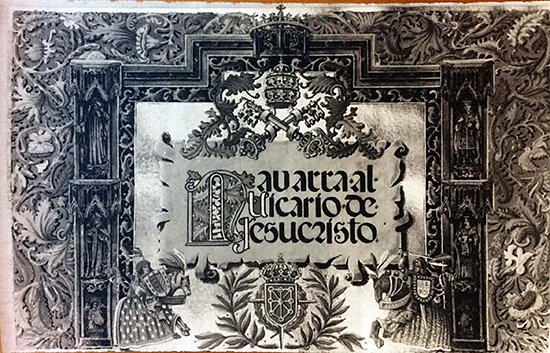
Dedication (Nicasio Albéniz)
(Photograph by Francisco Zubieta)
Behind the cover of the Book, that in its inner side has white satin guards ornamented with flowers and vegetal stems, a miniature title page is included and labeled in Gothic script by Nicasio Albéniz (whose signature is concealed in the lower right corner of the reader), and on golden cartouche the dedication to the Supreme Pontiff: Navarra al / Vicario de / Jesucristo (Navarre to the / Vicar of / Jesus Christ). This text, located in the middle, is under the emblem of the successor of Peter, the two keys of the kingdom of Heaven on mounted by the papal tiara, and under that, also in the center, the double laureate shield of Navarre accompanied on each side by two horsemen on horseback, with their caps and all, and the knights brandishing sword and with shield, their heads touched with feather ornament, all this set framed by the dust cover of an altarpiece decorated on the sides by figures of saints of the Church, highlighting all of it on a background of stems, palmettes and flowers in a variegated and well-delineated composition. The satin guards are repeated on the inside of the back cover. As explained above, in the replicated edition of the original, the silver covers have been replaced by parchment ones, but the originals were of sterling silver, with fine work embossed and chiseled, gilded with fine gold and with enameled coats of arms and decorative motifs, plus corner pieces and clasps for greater prestige and security. Its elaboration was directed in the Talleres de Arte, in Madrid, by the priest, sculptor, painter and liturgical goldsmith Félix Granda Buylla. The binding of the replicas was made in luxury edition by the bookbinder José Azurza, a well-known craftsman with business in San Agustín 38 of Pamplona, who knew how to elevate his official document to the category of art.
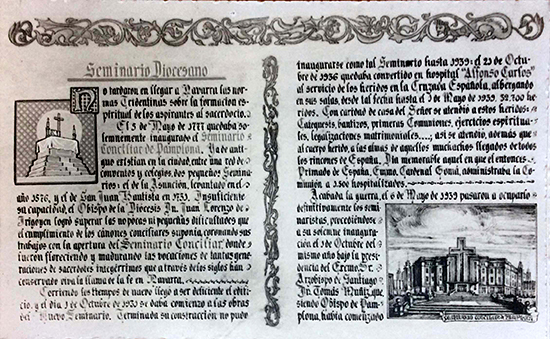
design of page
(Photograph by Francisco Zubieta)
The interior of the manuscript book is written in cursive gothic script, with borders, ornaments and vignettes in brush and various inks after the parchment has been degreased with talcum powder. The text pages have a double-column layout with justified margins (with financial aid of running dots) and paragraph beginnings with indentation of several spaces initiated with capital letters inserted in a motif referring to the topic to be treated. Each leaf of the manuscript invariably has a header consisting of a running border decorated with various arabesques, generally plant interlacing or phylacteries combined with human figures, warriors, angels, animals of an imagined bestiary (for example human heads with the body of a reptile whose tail is mixed with vegetation) or winged cocoons distributed around a central motif that is usually a vase, a cross in cartouche, a house, the anagram IHS[Iesus Homo Salvator] or the words PIVS XII - P. M. [Pius XII Pontifex Maximus] in keeping with the desire to personalize the book in the figure of its addressee, all evoking the candelieri decoration of the Renaissance. The two columns of the text are separated by a street or medianil in which a vertical band has been introduced that gives balance to the whole and is decorated in an imaginative way in the form of an axis from which leaves sprout as if it were a stem or in which a phylactery is twisted, aesthetically opposing the sinuosity to the verticality, in clear evocation of the framing frames of the baroque altarpieces. This band has finials in the form of small animals, warriors, birds, griffins, or the Cross as representative motifs.
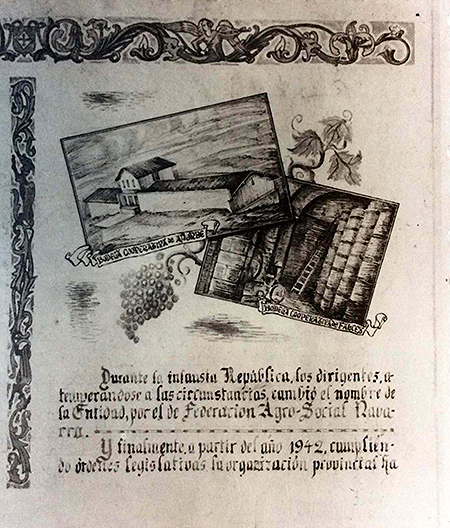
Example of vignettes
(Photograph by Francisco Zubieta)

Vignettes by Muro Urriza
(Photograph by Francisco Zubieta)

Vignette of Lozano de Sotés
(Photograph by Francisco Zubieta)
The text is accompanied by numerous rectangular or square vignettes of monuments, allusive figures, liturgical objects, compositions of figures, interiors of temples, views of towns, buildings dedicated to the teaching or to cooperativism, sanatoriums, emblems such as that of the Institución Príncipe de Viana, etc. There are also tables with numerical statistics (which make it necessary to break the paragraph), others data within cartouches with curved edges or framed by tasseled corners, with a neo-medieval flavor. In the drawing of some vignettes it is easy to identify the hand of Leocadio Muro Urriza, as is the case of the drawings that close the book: two musician angels of stylized canon and clean outline playing trumpets superimposed their figures to two circles, surely of bold chromatism that is not possible to appreciate in this photographic copy in black, in one of them (the left one) is inscribed the coat of arms of Pope Pius XII (a dove with a laurel branch in its beak perched on a promontory above the waters, symbol of life after the universal flood) and in the opposite one the registration AÑO / SANTO / 1950, the year of forgiveness, as a colophon of the Golden Book. Other vignettes are clearly the work of Pedro Lozano de Sotés, those referring to the requetés wounded on the front lines of combat or the penitent pilgrim before the sanctuary of Ujué, in which the firm modeling and the pronounced perspective of the motifs represented stand out. But, in general, it is not easy to distinguish work from other authors, most of them dedicated to ornamentation.
The neatness of the whole reveals the controlled artistic direction of project coordinated by Muro Urriza, to whom I believe most of the text labeling in gothic characters should be attributed, as the labeling of scrolls was one of his specialties, and, of course, the historicist air of the book as a whole stands out.
BIBLIOGRAPHY:
agreement of the Diputación Foral de Navarra of June 30, 1950 by which the undersigned deputy [José Ángel Zubiaur Alegre] is appointed to "organize and direct, with the collaboration and aid he deems necessary, the work of making the work in question [Album or Golden Book], reporting periodically to this Deputation, for the purposes of the appropriate agreements, on the progress of the work". (file JAZA).
file Royal and General of Navarre. To His Holiness Pope Pius XII, the ancient Kingdom of Navarre [:Holy Year 1950: this is the Golden Book of Navarre, because it gathers the Catholic spirit of the ancient Kingdom in loving homage to the Holy Father]. [Pamplona] : [Diputación Foral de Navarra], [1950?]
AUÑAMENDI EUSKO ENTZIKLOPEDIA. BERNARDO ESTORNÉS LASA FUND. Donostia-San Sebastián, Eusko Ikaskuntzaren Euskomedia Fundazioa, 2002-2013.
GREAT ENCYCLOPEDIA OF NAVARRE. Pamplona, Caja de Ahorros de Navarra, 1990, 11 vols.
MURUZÁBAL DEL SOLAR, J. M., "Leocadio Muro Urriza", in V.V.A.A. Pamplona. Year 7. Pamplona, Pamplona City Council, 2007, pp. 21-35.
